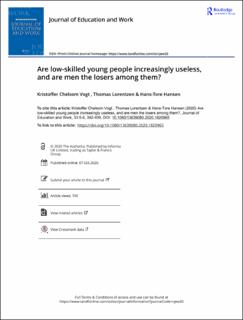| dc.contributor.author | Vogt, Kristoffer Chelsom | |
| dc.contributor.author | Lorentzen, Thomas | |
| dc.contributor.author | Hansen, Hans-Tore | |
| dc.date.accessioned | 2021-04-30T06:19:59Z | |
| dc.date.available | 2021-04-30T06:19:59Z | |
| dc.date.created | 2021-01-27T10:47:30Z | |
| dc.date.issued | 2020 | |
| dc.identifier.issn | 1363-9080 | |
| dc.identifier.uri | https://hdl.handle.net/11250/2740442 | |
| dc.description.abstract | Claims that low-skilled young people, and especially the men among them, are being excluded from the labour market have been influential over recent decades, contributing to an increasing concern over the issue of early school leaving. In this study, we use high-quality administrative data and sequence analysis to investigate the school-to-work trajectories of three birth cohorts of early school leavers in Norway between the ages of 16 and 26. Our observation period (from 1994 to 2015) covers several structural transformations of the Norwegian economy, such as increased migration, labour market polarisation and automatisation, widely held to have worsened the prospects of low-skilled young people. In accordance with expectations, we find some signs of increased labour market exclusion among early school leavers, relating to changes in welfare policy. However, the majority still follow trajectories characterised by employment and/or further education. Contrary to discourses on low-skilled men as losers, but in accordance with previous research, we find that male early school leavers consistently predominate in trajectories leading to middle and high incomes. Even in the comparatively gender equal country of Norway, the gender-segregated labour market consistently appears to be providing low-skilled men with more economically rewarding life course trajectories. | en_US |
| dc.language.iso | eng | en_US |
| dc.publisher | Routledge | en_US |
| dc.rights | Attribution-NonCommercial-NoDerivatives 4.0 Internasjonal | * |
| dc.rights.uri | http://creativecommons.org/licenses/by-nc-nd/4.0/deed.no | * |
| dc.title | Are low-skilled young people increasingly useless, and are men the losers among them? | en_US |
| dc.type | Journal article | en_US |
| dc.type | Peer reviewed | en_US |
| dc.description.version | publishedVersion | en_US |
| dc.rights.holder | Copyright 2020 The Author(s). | en_US |
| cristin.ispublished | true | |
| cristin.fulltext | original | |
| cristin.qualitycode | 2 | |
| dc.identifier.doi | https://doi.org/10.1080/13639080.2020.1820965 | |
| dc.identifier.cristin | 1880177 | |
| dc.source.journal | Journal of Education and Work | en_US |
| dc.source.pagenumber | 392-409 | en_US |
| dc.identifier.citation | Journal of Education and Work. 2020, 33 (5–6), 392-409. | en_US |
| dc.source.volume | 33 | en_US |
| dc.source.issue | 5-6 | en_US |

